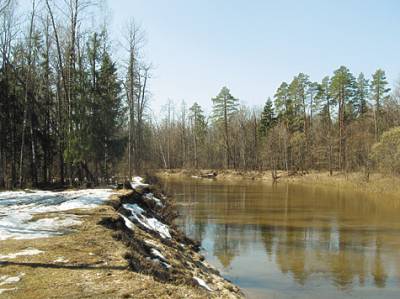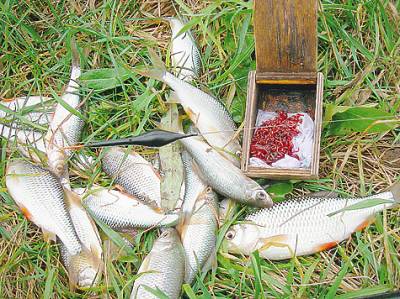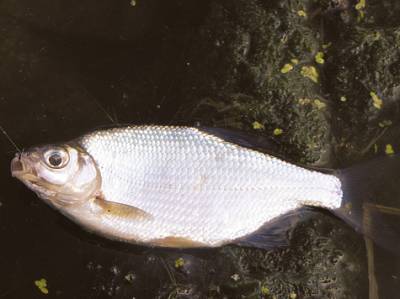
Normal size of the minnow is well known. Minnows traditionally fished in small rivers and even streams. In the summer you can literally choose a hunt from a standing flock of fish. Moving around the bottom of the blue over the minnows occasionally go to the core of the flow where behind cover waiting for a passing feed.
Minnows are almost never standing still. They simultaneously follow their chosen stream current, which changes direction because of the uneven flow. Almost all anglers know that this fish instantly responds to the emergence of any new jet flow, especially if it carries the dregs and food. This is based on the most common way of attracting minnows.
It is easier to create a haze, picking the bottom under the legs, standing in the jet flow. In the cold autumn water standing in water is not desirable. Besides, in the autumn of minnows go deeper, so we use bait. As bait used earth or clay with chopped worm, bloodworm or maggots. In cold water minnows can negatively react to the dregs, so the land can be replaced by a small number of standard basic bait for cold water with large fractions. Very good results are obtained by the use of stationary feeders filled with small bloodworms. If the right to choose the point of fishing, then one feeder with bloodworms lasts for a day of fishing.
The most difficult thing when using bait on the course is the proper choice of the point of complementary feeding. The error in this case will lead to the fact that instead of the gudgeon will eat small roach or bleak white bream.
At a deep place in the autumn, when there is no possibility to observe the movements of the minnow visually, you need to detect the Parking lot and only then to lure. The deep minnow leads a relatively sedentary and does not move with the selected jets for a long time. In General, the more depth, the better complementary feeding. To this must be added that deep space near the channel is the biggest fish. If the minnow in the river a lot, then you can be sure that among them there are giants with a length of 12, and even 15 centimeters.
With regard to gear and techniques of fishing, it is tied to the fishing conditions, given the fact that a minnow in the for the vast majority of cases takes the bait from the bottom. As Parking places of this fish are rarely far from the shore, as a tackle I suggest or a very short plug, or a light flywheel rod.
Harness to hold the bait on the bottom point of fishing involves the use of the equipment of relatively simple design. Sinker with a hook you can replace the jig with a small hook, having an elongated handguard, because the mouth of this fish is small. These apparatus are good in shallow water in the summer. In the autumn at a depth of more than a meter I always use a snap with a hook. It is very important that the snap was on the point of fishing, it is necessary to exclude the festival of float, and hence of the lure from side to side. For this selected stable float. I often use a float with the extended upper part of the body.
In that case, if the retention snap on the point of bait does not work, you need to make short, up to a meter in length transactions with drawing bait along the bottom.
From the flocks of three dozen fish you can almost always catch two or three minnows decent size. Strong opinion that a large minnow found only in the rivers, was incorrect. There are known cases of catching the giants with a length of almost 30 cm in a flow and key lakes. As for the multitude of minnows, not so far from Moscow there are lakes, and do not differ at record depths and very oxygen-rich water in which minnows much better than any Moscow river or the river.
In the lake to find the Parking lot minnow is much more difficult than in the river, but not only because they are more local. Difficult to find that in lakes the bite is less stable and occurs in some of the gaps. Even harder in the lake to find habitats large minnows and their point of feeding.
Interestingly, large minnows in the lake you can not detect on the sandy or rocky solid ground, and in places with a strong, albeit thin, layer of silt. Apparently, there is big fish finds bloodworms or caddis.
Based on the habits of lake minnow, its activation was found in the area it makes sense to use the bait based on the bloodworms. So, while catching roach or perch on bloodworms, revealed the presence of gudgeon.
On lakes and reservoirs first you need to determine what the depth of now is fish. This can only be done by trial and error. The chosen place lure, and it remains to wait patiently for a bite. Sometimes biting starts almost immediately, and sometimes you have to wait for a bite and hour. Catching minnows at the lake is reminiscent of fishing for roach and carp, with the only difference that the fish nearly always takes from the bottom. The bait may simply lie on the bottom or slowly dragging on it. If you feed very small doses small moth or more large larvae, the fish, like the perch in winter, and begins to climb toward the falling stern. At such moments, major gudgeon enough to fall about ten inches above the bottom. It is necessary each time to try. On the lake expect to succeed can be almost all day. Of course, if you’re lucky with the weather.
It is believed that the best baits for minnow are part of a worm and bloodworm. The worm is preferably found in the sandy banks to the water’s edge under rocks. Throughout the season the perfect bait is caddis worm any size and color, but better than the large caddis flies away for catching roach and small to give the minnow with its small mouth.
There are exceptions. In my practice there were cases when a large fish prefer to catch the maggot, and it is green in color, and it is almost never reacted to bloodworms. This happens if the river many caddis and the fish got used to it.
In the natural diet of the fish, except for larvae and worms, a certain and considerable place is occupied by plant components. This may explain cases a good bite on slices of bread. In any case, the nozzle have to choose the size that matches the size of the mouth of the minnow. For a big bait, this fish is often simply not responsive. The size of the bait and gets the hook.
Major gudgeon careful, so I use the lightest possible snap with floats up to 1 g on the line of 0.06 mm. the length of the leash not more than five centimeters. This is due to the fact that the fish bite severe, but short. Minnows readily grab the bait, which stops in front of the nose or varies very slowly floats past.
The float I choose the short, but not very thin antenna, otherwise the tightening of the float under the water surface flow will be perceived as a nibble. Delaying the float will happen in all cases, after the lure lies motionless on the bottom.
Small minnows need to go. Their use as live bait has lost relevance for several reasons. First, more and more anglers prefer spinning by jucovy gear. Secondly, now the sea good spinning imitations of minnows, and the need for snastochki with natural fish disappeared. Third, the purveyors of bait fish for the price have become greedy out of their wits. Fourth, this fish enough environmental problems from human action.
Large minnows in quantities of a dozen, no more, I’m fried. For this I once a year in autumn, make a special check on one of the small suburban rivers or running on deep forest pond. Except me, here minnow is not something that is not caught, but many are not even aware of his presence. And this is good because it’s Amateur hour fashion now feeder will not affect the population of this fish, but that’s the fun of fishing will spoil for sure. Unlike the swarms of locusts migrating through the reservoirs, anglers boorish education not just devastate the shores of the vegetation, but also abundantly fertilize their garbage. Take care of nature and its wonderful creatures — minnows!








